Posted by Elena del Valle on June 13, 2008
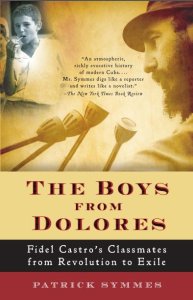
The Boys from Dolores book cover
Photo: Stephen Lewis
In The Boys from Dolores Fidel Castro’s Schoolmates from Revolution to Exile, a recently published book (Vintage, $15.95), Patrick Symmes tells the story of some of Cuba’s privileged boys from days gone by. Fidel Castro and his brother Raúl are among the many boys that attended the Colegio de Dolores, a private school on the island, in the 1940s.
In the 352-page book, the New York author describes the story of a group of boys he believes were an essential part of Cuba’s political and social history. The boys, chosen from among the most affluent and ambitious families in eastern Cuba, were groomed at the school Colegio de Dolores for achievement and leadership.

Author Patrick Symmes
According to promotional materials, Symmes tracked down dozens of schoolmates and shares some of their stories in the book. He includes their time at the Colegio and the effects of the revolution on their lives. The boys, he tells the reader, were trained by Jesuits for dialectical dexterity and the pursuit of absolutes.
He goes on to describe Fidel Castro in his formative youth, as an adolescent in the Colegio and in the streets of Santiago, the province where the school was located. Symmes traces the years in which the revolution was conceived and its evolution. He also describes the changes it produced in Santiago and in the lives of the boys. With Symmes’ help the reader can follow the boy’s life through the 1960s, as many left Cuba and a few stayed behind.
Symmes sets out to provide readers with a tour of the world that gave birth to Fidel Castro and the island his Cuban Revolution left behind. It is described as an “eye-opening portrait of Cuba in the twentieth century.” Symmes, a resident of New Yok, is the author of Chasing Che. He writes for Harper’s, New York, Outside, and Conde Nast Traveler magazines.

Click here to buy The Boys from Dolores
Comments:
Filed Under: Books
Posted by Elena del Valle on June 12, 2008
Information provided by our Event Partner

Marketing In a Teen Age: Innovative Strategies To Target Teen Consumers
Wednesday, June 25, 2008 – Thursday, June 26, 2008
The Times Center
242 West 41st Street
New York, NY 10018
What Teens Want, hosted by Adweek, Brandweek, Mediaweek, Billboard and The Hollywood Reporter, is the definitive marketing summit to learn how to target today’s trendsetting teens through social networking, cause branding, mobile/digital technology, fashion, music, movies, sports and video games. Join over 300 marketing, agency, media and retail executives and business managers at this 6th annual event.
Top 5 Reasons To Attend:
- Discover how to use social networking and other online marketing tools to build a big buzz about your brands on a small budget
- Hear exclusive research from Nielsen Mobile and The N/The MTVN Kids & Family Group
- Learn how to anticipate major market trends in order to keep your brands relevant to teen consumers
- Get straight answers to your questions from a live panel of teen boys and girls
- Connect with leading brand and agency experts at the MarTEENi Networking Reception
For the complete agenda and to register, please visit www.whatteenswant.com.
Posted by Elena del Valle on June 12, 2008
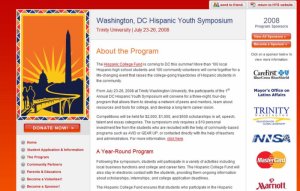
A Hispanic Youth Symposium website – click on image to enlarge
Photos: The Hispanic College Fund
Last week, the Hispanic College Fund launched seven regionally-focused websites dedicated to its annual Hispanic Youth Symposia taking place this summer. Each website is designed to provide an online forum for local communities to support their Hispanic Youth Symposium (HYS) by informing visitors about community partners and sponsors, and providing instructions on how to donate and volunteer.
Representatives of the Hispanic College Fund, established in 2004, hope to reach a national audience of 8,000 people. They are promoting the websites through a press release distribution, on the organization’s upcoming e-newsletter targeting 125,000 past scholarship applicants, and on Facebook.
In 2008, the Hispanic College Fund will offer a symposium in seven cities: Fresno, California; Phoenix, Arizona; Albuquerque, New Mexico; Washington, DC; Baltimore, Maryland; Fairfax and Richmond, Virginia. Organizers plan to expand the program to four or more cities in Southern California and other regions in 2009. Fund representatives believe that 1,400 students, participants in each of the seven 2008 Hispanic Youth Symposia across the nation, will directly benefit from the websites.
The websites provide information for students including how to apply for symposia that are still open and who to contact. There is also information on year-round programming that follows HYS, answers to frequently asked questions, an interactive national map and details about activities like workshops on business etiquette and resume writing. Visitors may also join the Hispanic College Fund’s list serve.

Lisa Sandoval, director of Communications, Hispanic College Fund
“The Hispanic College Fund believes that community involvement is the key to success for our Hispanic Youth Symposia,” said Lisa Sandoval, director of Communications for the Hispanic College Fund. “These websites embody our community-oriented focus on local students. Both fun and functional, the sites let local communities see that the Hispanic Youth Symposium is their very own.”
“Moving Beyond Traditional Media Measurement: measuring conversations and social media” audio recording

Presenter Katie Delahaye Paine, founder, KDPaine & Partners
Find out about
- Issues affecting online public relationships today
- Testing relationships as part of a survey
- Measuring ethnic group relationships
- Measuring foreign language communications in a similar ways to English
- Biggest challenges measuring conversations and social media
- Measuring online relationships with little or no money
Click here for information on “Moving Beyond Traditional Media Measurement”
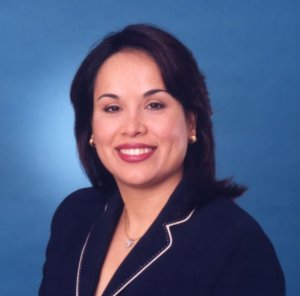
Idalia Fernandez, president, Hispanic College Fund
“A heavy investment has been made in these sites because the Hispanic College Fund recognizes the power of creating positive change at the grassroots level,” said Idalia Fernandez, president of the Hispanic College Fund. “With students getting much of their information from social networking sites like Facebook, we want these sites to be just as exciting while providing substantial information for all students, as well as the community at large. In fact, the websites include a link to a Hispanic Youth Symposium Facebook Cause, where students can obtain information about college and career opportunities posted by their peers.”
The Hispanic Youth Symposium Program is dedicated to creating a pool of Hispanic high school students focused on attending college and securing professional careers. Ideal participants are Hispanic high school students who live in one of the seven cities and surrounding counties where this year’s symposia will take place; have a GPA of 2.5 or higher; and will be a sophomore, junior, or senior next year.
During the initiative, 200 students travel to a local college campus for a three-night, four-day program. The short term goal is for students develop a network of like-minded peers, connect with role models and mentors, learn about resources that will earn them a seat in college, compete for scholarships, and develop long-term career vision.
Hispanic Marketing and Public Relations Understanding and Targeting America’s Largest Minority book
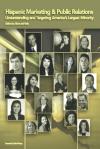
“A must resource for practitioners/professionals expecting to reach US Hispanics; also valuable for college programs in marketing, public relations and communications. Highly recommended.”
Choice magazine
Click here for information on the Hispanic Marketing & Public Relations books
More than 100 community volunteers assist with on-site coordination while businesses provide sponsorships, speakers, mentors, and recruiting opportunities. Representatives from various colleges present sessions on college preparation and admission. Following the symposium, participants may have access to additional information and resources to further their college bound goals. Funding is based on donations from individual donors and corporate sponsors, including companies such as Sallie Mae, Lockheed Martin, and Google.
“We still need funding for 400 of the 1,300 students attending symposia this summer. We are currently launching a Match Campaign in which an anonymous donor will match a percentage of the total amount we are able to raise in order to fund these 400 students,” said Sandoval.
Founded in 1993, the Hispanic College Fund is a non-profit organization based in Washington, D.C., with a mission is to develop the next generation of Hispanic professionals. The organization has provided scholarships internship and mentoring programs for students throughout the United States and Puerto Rico. The Hispanic College Fund has an annual budget of $6 million and 20 full-time employees.
“Beyond the 30 Second Spot” audio recording
Listen to a 105-minute discussion




Panelists Ivan Cevallos, Hunter Heller, Kitty Kolding and Cynthia Nelson
Our panel of national experts discuss
• Challenges of measuring the impact of the 30-second ad spot
• Innovative tools are useful to reach Latinos
• Changes in marketing to Hispanics
• On which market segment are the changes most relevant
• Effects of technology and time shift on consumer behavior
• Role of multi-screens
• Getting started
• Tips for marketing professionals
Click here for information on Beyond the 30 Second Spot
Posted by Elena del Valle on June 11, 2008
Are you a cutting edge PR professional looking to lead a high profile multicultural practice at Edelman? We have a unique opportunity for an EVP to lead our teams in providing our clients with the best insights into the U.S. multicultural markets. This person will lead the team that develops award-winning multicultural campaigns for a broad range of clients.
Click here for the full text of Executive Vice President, Multicultural
Posted by Elena del Valle on June 11, 2008
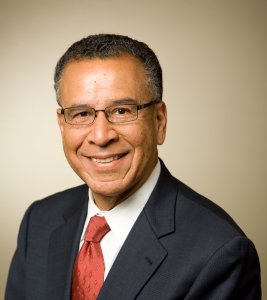
Jacob Lozada, board member, AARP
Photo: AARP
Some Hispanics feel the impact of recent economic hardships more harshly than other groups, according to a recent 32-page report prepared by Gerard Rainville and released by the American Association of Retired People (AARP). The findings are based on a national telephone survey, in English and Spanish, of 1,002 adults 45 years of age and older conducted by Woelfel Research, Inc. between April 12 and April 23, 2008. The individuals selected were part of a nationally representative sample that included 400 Hispanics. Researchers generalized their findings by including an oversample of Latino respondents.
The survey, The Economic Slowdown’s Impact on Middle-Aged and Older Hispanics, part of AARP’s examination of how Americans 45 and older are faring through economic difficulties, found that 86 percent of Hispanics 45 and older who were surveyed said the economy is in fairly bad or very bad condition, and 82 percent said it is getting worse.
“The current economic downturn is forcing many in the Hispanic community to take very difficult choices between their immediate needs and long-term financial security,” said Jacob Lozada, board member of AARP.
The AARP study led researchers to conclude that two-thirds of all Americans 45 and older are having a harder time paying for food, gas and medicine. At the same time, they concluded four in five Hispanic respondents (80 percent) are struggling to afford daily necessities.
“Segmentation by Level of Acculturation” audio recording

Presenter Miguel Gomez Winebrenner
Discusses
- Assimilation versus acculturation
- Factors that affect Latino acculturation
- How to know if someone is acculturated
- Number of years necessary for acculturation
- Effects of immigration debate on acculturation
- Three main ways of segmenting Latinos
Click here for details about “Segmentation by Level of Acculturation”
The researchers also believe middle aged and older Hispanics are more likely than the general population of people 45 and older to have difficulty paying their mortgage or rent (41 percent to 26 percent), and paying for educational expenses (32 percent to 19 percent). AARP representatives also believe Latinos are suffering more acutely as a result of the high foreclosure rates. Forty-one percent of respondents to the survey said they are feeling concerned about losing their home and 77 percent said they worry about the safety of neighborhoods with many foreclosed homes.
AARP representatives believe economic pressures are forcing middle-aged and older Hispanics to make difficult choices that could have dire long-term consequences. One third of the 400 individuals surveyed by phone said they had stopped depositing money into a 401(k), IRA or other retirement account, and more than 26 percent said they are prematurely raiding these savings accounts. Twenty–two percent of those surveyed said they are cutting back on medications and 31 percent said they have postponed paying some bills.
“We are going to feel the effects of this economic crisis for many years to come,” said Lozada. “Raiding your nest egg has a compounding effect because that money is not allowed to grow at a time when you have fewer working years to make up the losses.”
On the other hand, many of those surveyed said they are spending cautiously, spending less on entertainment and eating out (71 percent) while 62 percent are postponing travel plans and major purchases. About one quarter of respondents said they postponed retirement plans and 23 percent said they are working more hours.
Many of respondents, 44 percent, helped a child with bills or expenses and 18 percent helped their parents in the same way. Fourteen percent allowed one of their children to move in with them for financial reasons and 5 percent allowed their parents to do the same. Ten percent of participants in the survey sought help from family, churches or charities.
AARP is a nonprofit, nonpartisan membership organization of 39 million people aged 50 and older. Two of AARP’s board members are Hispanic. According to the AARP website, in April 2007 1.2 million of the organization’s members were Hispanic.
Target Latinos effectively by anticipating changes in the market with
“Hispanic Projections with 2007-08 update” audio recording

Presenter Roger Selbert, Ph.D.
Find out
- About Latino buying power growth in the future
- How Latino market growth compares with other markets in the U.S.
- What drives the rise of Latino economic clout
- Who should target the Latino market
- What is the size of the Hispanic affluent market
- If the luxury Latino market is growing
Stay ahead of your competition with “Hispanic Projections”
Posted by Elena del Valle on June 10, 2008
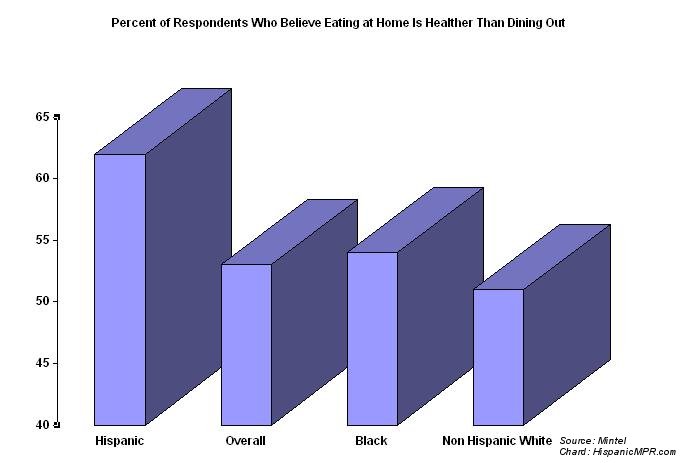
Dining out preferences by ethnic group – click on image to enlarge
Photos: Mintel, Pizza Patron
According to a recent study, people are dining out less often because of economic hardships. At the same time, the study indicates growth in restaurants in the coming years will be the result of patronage from Echo Boomers (children of Baby Boomers) and Hispanic and Asian immigrants.
Studies indicate ethnic restaurant goers are more likely to seek exotic flavors. This is significant because some researchers believe the Echo Boom generation, many of which are immigrants or children of immigrants, will show the greatest increase in percentage of the overall population between 2002 and 2012.
A November 2007 study by the National Restaurant Association, indicates restaurant activity has fallen to its lowest level since February 2003 because customers are dining out less frequently. It is also noteworthy that 51 percent of restaurants surveyed expect economic conditions to worsen in the coming months. Mintel research from January 2008 indicates that 54 percent of people who dine out regularly are cutting back on restaurant spending because of the economy.
“Best in Class Hispanic Strategies” audio recording


Presenters Carlos Santiago and Derene Allen
-
Find out what makes 25 percent of the top 500 Hispanic market advertisers out perform the remaining companies
-
Discover what questions to ask, steps to take to be a Best in Class company
Click here for more about “Best in Class Hispanic Strategies” audio recording
Many Americans are eating out less often blaming their decision on the skyrocketing price of fuel and increases in many consumer goods including food, as well as the boom in home foreclosures and the recession. Seventy percent of consumers who responded to the Mintel survey are attempting to save on meals by going out to eat fewer times a month instead of choosing cheaper entrees or dining at less expensive restaurants.

David Morris, senior analyst, Mintel
“People aren’t trading down for cheaper or lower quality food; they’re just trading out,” said David Morris, senior analyst at Mintel. “Especially when you consider the price of casual and fine dining, staying in can reduce costs significantly.”
Hispanics many not be surprised to discover that few Latino oriented selections were found among the national trends identified by Mintel researchers. The company’s executive summary indicates that “Although efforts to target the Hispanic community are notable, there is a lack of Hispanic taste-inspired menu items that would likely be a popular addition.”
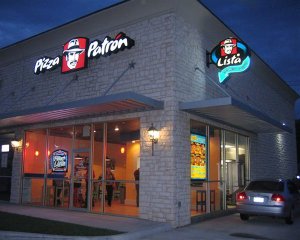
A Pizza Patron restaurant
In general, adults 18 to 24 years old are the group most likely to say that they are spending more. Older adults, aged 45 to 54 are those most likely to cut back on spending. Hispanics respondents were the most likely to believe at home meals are healthiest. Sixty-two percent of Latino respondents believed “I could eat healthier if I ate at home instead of going to a restaurant;” compared to consumers overall (53 percent), white (51 percent) and black (54 percent) respondents.
The Mintel survey was weighted against the U.S. population to make it representative of the varied demographic groups For the purposes of this report, Mintel commissioned exclusive consumer research through Greenfield Online to explore consumer attitudes towards dining out. Researchers conducted fieldwork in January 2008 among a nationally representative sample of 2,000 adults aged 18 and older.
Mintel also analyzed data from Simmons Research, using the National Consumer Survey (NCS) which was conducted between May 2006 and June 2007. The results presented in the Mintel study are based on a sample of 25,375 adults 18 and older with results weighted to represent the U.S. population.
Founded in 1919, the National Restaurant Association is a restaurant industry business association. Mintel, founded in the United Kingdom 35 years ago, is a supplier of consumer, media and market research. The company, with offices in Chicago, London, Belfast, Sydney and Shanghai, has been studying the United States Hispanic market since 2003.
Hispanic Marketing and Public Relations Understanding and Targeting America’s Largest Minority book

“A must resource for practitioners/professionals expecting to reach US Hispanics; also valuable for college programs in marketing, public relations and communications. Highly recommended.”
Choice magazine
Click here for information on the Hispanic Marketing & Public Relations books
Posted by Elena del Valle on June 9, 2008
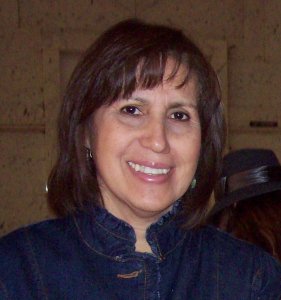
Maria Lopez De Leon, executive director, National Association of Latino Arts and Culture

Artist Laura Varela
Photos: National Association of Latino Arts and Culture, Laura Varela
A podcast interview with Maria Lopez De Leon, executive director, National Association of Latino Arts and Culture (NALAC), and Laura Varela, a San Antonio-based documentary film maker and media artist, is available in the Podcast Section of Hispanic Marketing & Public Relations, HispanicMPR.com. During the podcast, Maria and Laura discuss Latinos and the arts as well as NALAC and Laura’s work with Elena del Valle, host of the HispanicMPR.com podcast.
Maria has been with NALAC for over nine years and served as executive director for six years. She has been involved in all aspects of development and implementation of the organization’s programs and strategic planning.
Under her leadership, NALAC launched the NALAC Fund for the Arts, a grant program for Latino artists and organizations; completed production of a documentary series on Latino art and culture for the Public Broadcasting System; directed the convening of three national arts and cultural conferences and has lead the continued development of the annual Leadership Institute. She has also launched efforts to purchase a historic site to serve as NALAC’s national offices.
Maria has served as a panelist for the National Endowment for the Arts, City of San Antonio Office of Cultural Affairs, Houston Arts Alliance, City of El Paso Museums and Cultural Affairs and the Hispanic Heritage Arts and Entertainment Award. She was selected to participate in the Wallace Foundation “Leadership in Excellence and Arts Participation” (LEAP) program in 2005, and completed a peer mentorship program at the Mexican Fine Arts Center Museum. She has completed training in Technology of Participation group facilitation methods. In 2005, Maria received the Community and Culture award from San Antonio Cultural Arts, and in 2006 she was recognized with an award from Southwest Workers Network for her work and support of community in the struggle to achieve justice.
“Emotional Branding: How to capture the heart and mind of the Hispanic consumer” audio recording


“Emotional Branding” was recorded January 2007 during the Strategic Research Institute 13th Annual Blockbuster Marketing to U.S. Hispanic and Latin America conference in Miami, Florida.
Click here for your free copy of Emotional Branding
Laura is a San Antonio-based media artist, activist and educator originally from the U.S./Mexico border town of El Paso, Texas. Her projects are community-based and focus on issues of social justice and cultural preservation. She is a recipient of the Humanities Texas Media Arts grant for her current project As Long as I Remember: American Veteranos, which examines the legacy of the Vietnam War in the Chicano community from the point of view of artists.
This project was also selected for funding by Latino Public Broadcasting (part of the CPB Minority Consortia) and is in post-production with an intended PBS broadcast in 2008. Laura is developing raúlrsalinas and the Poetry of Liberation, a feature documentary about the life and times of Xicano poet and activist raúl r salinas. This program is also funded by Humanities Texas and Independent Television Service and the NALAC fund for the arts.
In San Antonio, her installation work has been exhibited by the Blue Star Art Space, The Esperanza Peace and Justice Center, Gallista Gallery, and the UTSA Downtown Art Gallery. She is an alumnus of the 2006 CPB/PBS Producers Academy, the 2006 NALAC Leadership Institute, and the 2003 NALIP/UCLA Latino Producers Academy. Her youth work in San Antonio includes organizations like the Esperanza Peace and Justice Center and the Guadalupe Cultural Arts Center, and KLRN. Artist residencies include Swarthmore College, Pennsylvanie, Art for Change, New York, New York. She recently returned from Hochschule Niederrhein, Monchengladbach, Germany.
To listen to the interview, scroll down until you see “Podcast” on the right hand side, then select “HMPR Maria Lopez De Leon, Laura Varela,” click on the play button below or download the MP3 file to your iPod or MP3 player to listen on the go, in your car or at home. To download it, click on the arrow of the recording you wish to copy and save to disk. The podcast will remain listed in the June 2008 section of the podcast archive.
“Moving Beyond Traditional Media Measurement: measuring conversations and social media” audio recording

Presenter Katie Delahaye Paine, founder, KDPaine & Partners
Find out about
- Issues affecting online public relationships today
- Testing relationships as part of a survey
- Measuring ethnic group relationships
- Measuring foreign language communications in a similar ways to English
- Biggest challenges measuring conversations and social media
- Measuring online relationships with little or no money
Click here for information on “Moving Beyond Traditional Media Measurement”
Posted by Elena del Valle on June 6, 2008

Maria la del Barrio DVD cover
Photo: Xenon Pictures
Xenon Pictures, in association with Lionsgate Home Entertainment, recently released the telenovela Maria la del Barrio on DVD. The Spanish language soap is part of a three part series in actress Thalia’s Maria Trilogy. The other serialized program, MariMar, was released earlier this year and the third part, Maria Mercedes, is due for release on DVD this summer.
Some fans consider that this series launched the famed Mexican soap actress into international stardom. Maria la del Barrio was also the first starring role for Fernando Colunga, described in promotional materials as the only actor to have starred in five successive hit telenovelas. Maria la del Barrio also stars actress Iran Eory and Itati Cantoral, whose portrayal of the evil Soraya earned her the 1996 TVyNovelas magazine award for Best Villain.
“Beyond the 30 Second Spot” audio recording
Listen to a 105-minute discussion




Panelists Ivan Cevallos, Hunter Heller, Kitty Kolding and Cynthia Nelson
Our panel of national experts discuss
• Challenges of measuring the impact of the 30-second ad spot
• Innovative tools are useful to reach Latinos
• Changes in marketing to Hispanics
• On which market segment are the changes most relevant
• Effects of technology and time shift on consumer behavior
• Role of multi-screens
• Getting started
• Tips for marketing professionals
Click here for information on Beyond the 30 Second Spot
Filmed in Las Lomas de Chapultepec in Mexico City, Maria la del Barrio was written by Ines Rodena (Marimar, Marisol) and directed by Beatriz Sheridan (La Intrusa, La Usurpadora). The soap opera like series aired initially on prime time in 1996 in the United States and 119 other countries.
In Maria la del Barrio, María Hernández (Thalia) is a poor and beautiful 15-year-old girl, forced to scavenge food to support herself and her elderly godmother. When her godmother dies, she goes to live with the wealthy Don Fernando de la Vega (Ricardo Blume). While she lives there she is resented by his new wife, Victoria (Eory), and her niece, Soraya (Cantoral).
María falls in love with the handsome but drunken son of the house, Luis Fernando (Colunga), arousing the jealousy of Soraya. He falls in love with her as well and asks her to marry him. Their happiness is cut short when a misunderstanding separates them. In her grief María gives up their child for adoption. although Luis Fernando returns and they adopt a child together she maintains hope of one day finding the son she gave up for adoption.
The 3-disc DVD set of Maria la del Barrio, with 12 hours (700 minutes) of content, is in Spanish with English subtitles. It is rated TV-PG. Maria la del Barrio has a suggested retail price of $24.98.


Click here to buy Maria La del Barrio and Mari Mar
and Mari Mar  on DVD
on DVD
Posted by Elena del Valle on June 5, 2008

LegalMatch website – click on image to enlarge
Photos: LegalMatch
LegalMatch has begun translating a few of the 4,000 pages on its legal matching website into Spanish with the goal of targeting Spanish speaking Latinos searching for legal advice, especially for immigration issues. So far the company has translated its homepage, intake processes for each category of law and some pages of its law library. Plans are in place to translate the remaining pages in the coming months.
“Finding the right lawyer in the United States is difficult enough if you speak English and know something about the law,” said Anna Ostrovsky, general counsel and co-founder of LegalMatch. “If you are not familiar with the United States legal system, and don’t speak English, it’s even harder. We created LegalMatch to empower consumers seeking the right attorney for their legal needs. Making LegalMatch available in Spanish was a logical next move for us.”
Five percent of the thousands of attorney members responded to a recent survey about their interest in Spanish language cases. Seventy-five percent of those who responded said they would be interested in receiving Spanish language cases; 44 percent said they spoke Spanish; and an 43 percent said they had Spanish-speaking staff members.
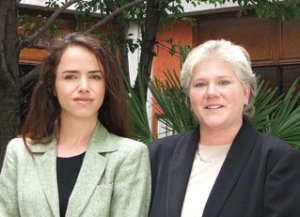
Anna Ostrovsky, general counsel and co-founder, and Laurie Ziffrin, CEO, LegalMatch
“We are very excited about the launch of our service in Spanish,” said Laurie Ziffrin, chief executive officer, LegalMatch. “Spanish is the primary language for about 15 percent of all U.S. residents. LegalMatch is proud to make its lawyer finding service available to this historically underserved group.”
Make your ads resonate with Hispanics
Listen to C&R’s Research Director Liria Barbosa in
“Hispanics’ Perspective on Advertising” audio recording

Liria Barbosa gives a presentation and participates in an extended Q&A discussion about
• Type of ads Latinos prefer
• Latino top media choices
• Percent of Latinos who tried products because of ads
• Percent of Latinos who purchased products because of ads
• What makes an ad “Hispanic”
• If ad language is important for bicultural Latinos
• What to keep in mind when targeting bicultural Latinos with ads
Click here for information on Hispanic Perspectives on Advertising
“Our Spanish site launch is our first major outreach aimed specifically at the Hispanic community. Before the launch, we likely had many Hispanics using the site in English, but we do not track ethnicity as part of our intake,” said a company representative. “So, we had no way of knowing the race or ethnicity of any of our clients. Once a few months pass after the launch, we will be better able to answer this question, as we will know what percent of clients choose to use the Spanish intake as opposed to English.”
LegalMatch, based in San Francisco, California with offices in Los Angeles, and Austin, Texas, was established in 1999 as a website targeting small business owners and individuals seeking legal counsel. According to the company website, it operated in the 50 states. The company is owned by dozens of shareholders and has 80 employees.
Posted by Elena del Valle on June 4, 2008
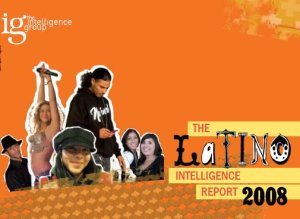
2008 Latino Lifestyle Study cover
Photo: The Intelligence Group
Many researchers believe the U.S. Latino population will triple in size and account for most of the nation’s growth from 2005 through 2050. Much of that increase is attributed to young Latinos who are struggling with their self identity, aspirations, hopes and dreams. How can marketers understand Latino youth when these young people are still searching for their role in American society? Will future Latinos be integrated into the mainstream as many generations of immigrants have done before them or will they cling to their cultural heritage as their parents have in the past decades? No one knows for sure.
In an effort to reach marketers targeting this fast growing ethnic group, The Intelligence Group recently released the third annual edition of its subscription based study of Latino youth. The 2008 Latino Lifestyle Study was designed as a forecasting tool for marketers looking to understand the 14 to 34 year old Latino consumer.
The Latino Intelligence Report is 150 pages in length and is available in a hard copy as well as CD. To help their researchers find the pulse of the booming market segment, The Intelligence Group tapped Christy Haubegger. The report is divided into six distinct sections: Themes & Trends, Language & Identify, Attitudes & Behavior, Entertainment, Tech & Web, and Marketing & Retail. The cost for the report is $25,000 per subscription which includes a copy of the report and one customized presentation of the report findings.
Target Latinos effectively by anticipating changes in the market with
“Hispanic Projections with 2007-08 update” audio recording

Presenter Roger Selbert, Ph.D.
Find out
- About Latino buying power growth in the future
- How Latino market growth compares with other markets in the U.S.
- What drives the rise of Latino economic clout
- Who should target the Latino market
- What is the size of the Hispanic affluent market
- If the luxury Latino market is growing
Stay ahead of your competition with “Hispanic Projections”
“Unlike their ancestors, young Latinos embrace technology, are predominantly bi-lingual, and are the leaders of both their families and their larger communities,” said Jane Buckingham, president of The Intelligence Group. “It is more important than ever for marketers to find ways to communicate with this growing demographic.”
The study is based on a telephone survey of 1,000 Latino youth in eight Hispanic markets, 1,028 online interviews conducted among 14 to 24 year old Hispanics. Telephone interview participants were recruited for age and gender balance, and interviews were conducted in the language of the participant’s choice by bilingual interviewers.
The researchers conducted online interviews nationwide, with quotas established by market and region to reflect the national Latino population. Online interviews were conducted, with respondents who self-identified as Hispanics, between November 30 and December 20, 2007.
Hispanic Marketing and Public Relations Understanding and Targeting America’s Largest Minority book

“A must resource for practitioners/professionals expecting to reach US Hispanics; also valuable for college programs in marketing, public relations and communications. Highly recommended.”
Choice magazine
Click here for information on the Hispanic Marketing & Public Relations books
Researchers also conducted focus groups and individual, in-person interviews with Latinos between 14 and 24 years of age in New York, Los Angeles, Miami, and Houston. They segmented the focus groups by age, gender and language. The Latino Intelligence Report includes attitudinal and behavioral comparisons to general market findings from The Cassandra Report, the company’s general market study that tracks attitudes and trends among young people. The Cassandra Report sample was generated from an online sample of 600 respondents ages 14 to 24.

Christy Haubegger, founder, Latina magazine
“Today’s young Latinos have one foot in each culture and feel very influential in both,” said Haubegger, who founded Latina magazine and Creative Artists Agency. “Marketers will have success if they embrace these notions and create campaigns geared toward culture, not language.”
According to promotional materials, the annual Latino youth study is made up of online surveys, focus groups, and in-person interviews. This year’s report identifies 10 themes the researchers believe will be useful to marketers: Bi-Dentity, The 40 Percent Perception, The American (Latino) Dream, Experience Economy, Flipping The Script, Social Connectors, Latinas Rising, Key Influencers, Mix Mash, Cautious Optimism; and identifies their favorite marketers in the segment. The report also provides an overview of the attitudes, behaviors and preferences the researchers identified among the young Latinos who participated in the study.
Some of the report findings shared by the publishers (the full report was not made available to Hispanic Marketing & Public Relations) include: The 40 Percent Perception, the belief by those surveyed that Latinos represent 40 percent of the United States overall market; Latinas Rising, the sense of empowerment young Latinas expressed in the study; Cautious Optimism, the researchers’ impression that the youth surveyed were optimistic and socially oriented; and Social Networking, the study subjects strong online presence which was identical to non Hispanics in the same age group.
The Intelligence Group is a market research, trend forecasting, and marketing consulting group focusing on Gen X, Gen Y, moms, teens, and tweens. The company, a division of Creative Artists Agency, also publishes the Cassandra Report, a lifestyle study of 14-34-year-old mainstream consumers and trend setters. Creative Artists Agency is a talent and sports agency that represents individuals working in film, television, music, theater, sports and video games, and provides marketing services to corporate clients.
Make your ads resonate with Hispanics
Listen to C&R’s Research Director Liria Barbosa in
“Hispanics’ Perspective on Advertising” audio recording

Liria Barbosa gives a presentation and participates in an extended Q&A discussion about
• Type of ads Latinos prefer
• Latino top media choices
• Percent of Latinos who tried products because of ads
• Percent of Latinos who purchased products because of ads
• What makes an ad “Hispanic”
• If ad language is important for bicultural Latinos
• What to keep in mind when targeting bicultural Latinos with ads
Click here for information on Hispanic Perspectives on Advertising










































